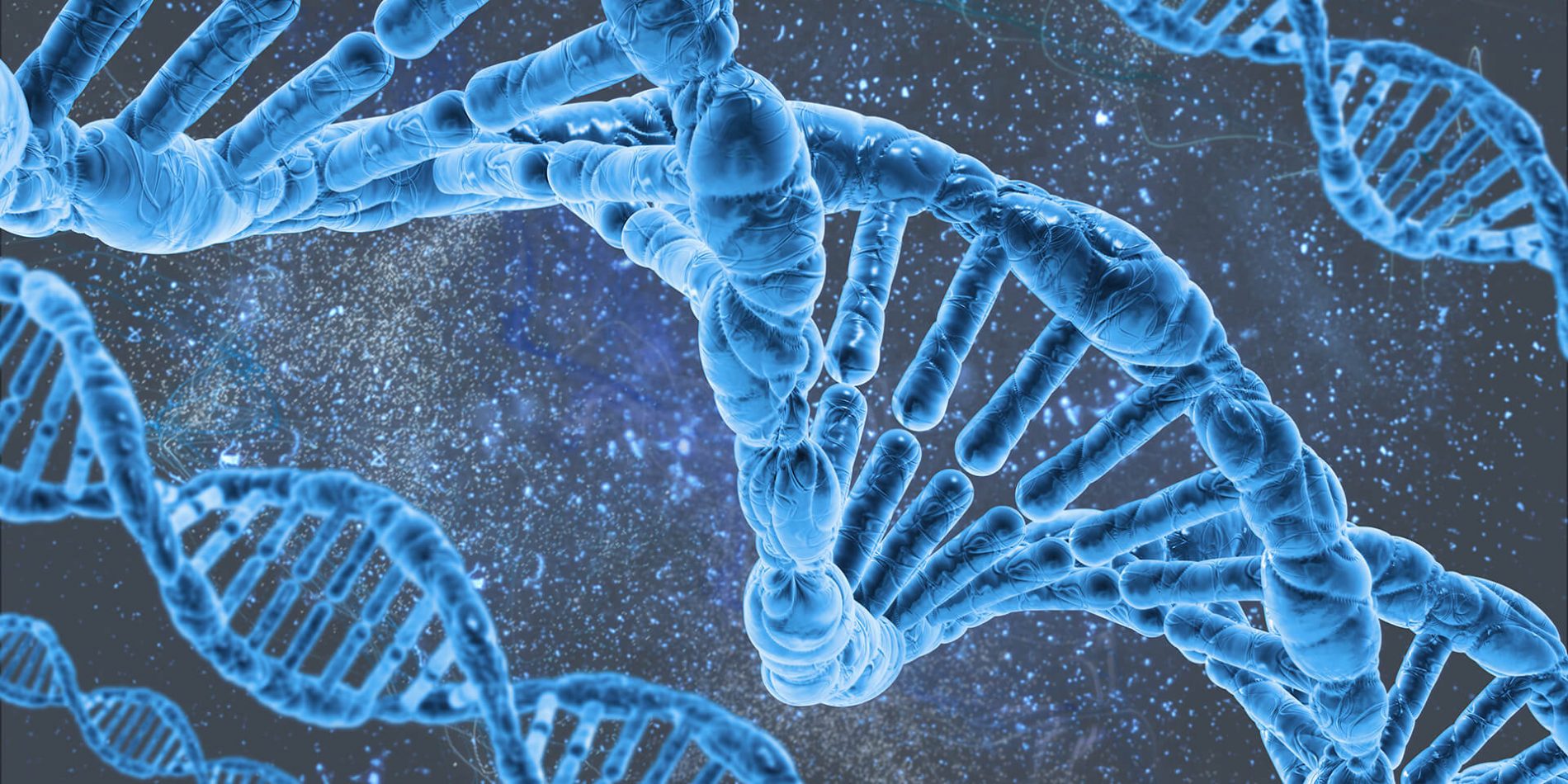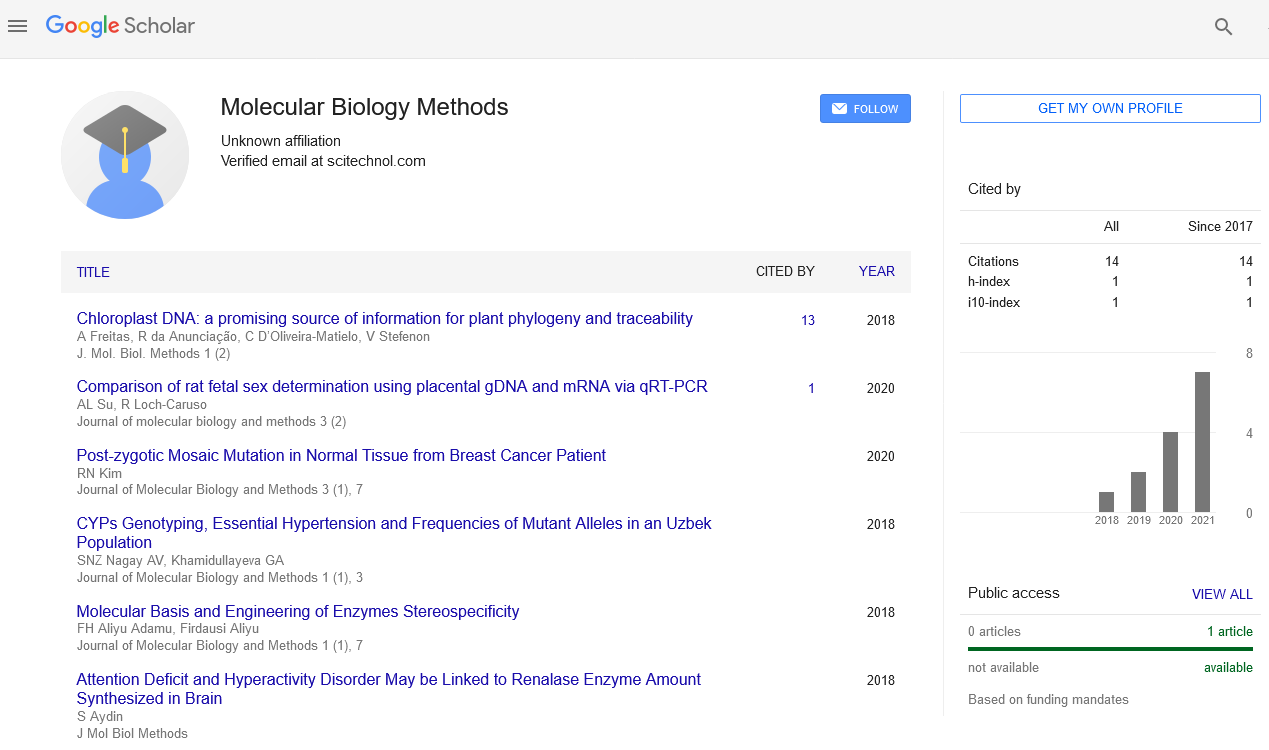About the Journal
Journal of Molecular Biology and Methods is an international peer reviewed, Open access Journal, dedicated to cutting edge research of interdisciplinary Biomolecular Sciences. The Journal directed towards exploring all key areas of basic and modern Molecular Biology and state of art innovative techniques across Molecular Biosciences.
Journal of Molecular Biology and Methods aims to highlight analytical and experimental methods and techniques, rapid developments, new discoveries, theoretical mechanisms and practical applications in biology and medicine through its scholarly publications and write ups of all types like research articles, review, case reports, case study, commentary, letter to editor, mini review, opinion, short communication, book review, editorials etc.
Submit manuscripts at Online Submission System or an e-mail attachment to the Editorial Office at manuscript@scitechnol.com
The Journal encourages submissions on broad range disciplines spanning diverse molecular biological interests with strong emphasis on biomedical research:
- Biochemistry
- Cell and Molecular Biology
- Structural Biology
- Genes and Genetic Engineering
- Developmental Biology
- Biophysics
- Bioinformatics
- Tumor Biology
- Microbiology and Immunology
- Neurobiology
- Molecular Biology Laboratory Techniques like - Recombinant DNA technology and molecular cloning, DNA sequencing, Polymerase chain reaction (PCR), Gel electrophoresis, Macromolecule blotting and probing, Immunochemical techniques, Microarrays, etc.
The Journal is an online refereed publication disseminating high quality research through original research, reviews, case reports, commentaries, opinion articles, short communications, editorials, Letter to Editor and others, etc. Journal strictly follows the peer-review process for the unbiased evaluation and publication. All the submitted manuscripts undergo peer review based on the initial quality check process and editor screening. The manuscripts qualified from quality check will be allowed for review by the subject matter expert referees, under the guidance of the Handling Editor or Editor-in-Chief of the Journal. The Journal invites potential authors to bring out novel researches in the field of Molecular Biology through scientific publications.
Biochemistry
Biochemistry is the study of chemical processes within relation to living organisms which give rise to the complexity of life. It is a combination of biology and chemistry and further divided into three fields such as molecular genetics, protein science and metabolism.
Cell and Molecular Biology
It is study of the cell as a separate unit and as part of a larger organism. The most important tool for modern cell biology is molecular biology, which deals with the molecular basis of biological activity. It involves study of human, animal or plant cell cultures in connection with genetic, biochemical, or physiological examinations.
Structural biology
Structural biology is a sub division of molecular biology, biochemistry, and biophysics. It is the study of molecular structure and dynamics of biological macromolecules, specifically proteins and nucleic acids. It also deals with how alterations in their structures affect their function. Structural biology assimilates the principles of molecular biology, biochemistry and biophysics.
Genetic Engineering
A set of technologies used to change the genetic makeup of cells, including the transfer of genes within and across species boundaries to produce improved or novel organisms. It is also known as genetic modification or genetic manipulation.By using Genetic Engineering we are able to do alterations in Genes (sequence of nucleotides in DNA or RNA that codes for a molecule that has a function) by modification of DNA which help is targeting the genome. This field opens much unknown facts and made major contribution in field of medical treatment and Pharmaceuticals.
Developmental Biology
Developmental biology is the study of the process by which animals and plants grow and develop. Developmental biology also encloses the biology of regeneration, asexual reproduction, metamorphosis, and the growth and differentiation of stem cells in the adult organism.
Biophysics
Biophysics is combination of Physics and biology which aims applies approaches and methods used in physics to study biological phenomena. It helps in study of all biological organization from molecular to organismic and populations such as interactions between the various systems of a cell as well as how these interactions are regulated.
Apoptosis
Apoptosis is a process of programmed cell death or “cellular suicide” that occurs in multicellular organisms is crucial for various processes, viz. normal cell turnover, proper development and functioning of the immune system, embryonic development etc. Biochemical events (energy-dependent) lead to characteristic morphological changes and death.
Epigenetics
Epigenetics, in the field of genetics, is the study of potentially heritable changes in gene expression (active versus inactive genes) that does not involve changes to the underlying DNA sequence — a change in phenotype without a change in genotype —that switch genes on and off and affect how cells read genes.
Cell Synthesis
Cell synthesis involves the synthesis of various proteins and other requisite molecules that are vital for the development and functioning of the cell. Cell synthesis is essential for the growth and development of the cell.
Neurobiology
Neurobiology is a part of science that centers around the structure and capacity of the sensory system in animals and people. It is a vital field, and one that has turned out to be basic for the comprehension of animal and human physiology. It manages the life structures, physiology, and pathology of the sensory system. It includes investigation of cells of the sensory system and the association of these cells into utilitarian circuits that procedure data and intercede conduct.
Immunology
Immunology is the investigation of how the body prevents disease. The part of science managing the segments of the immune framework, invulnerability from sickness, immune response, and immunologic methods of investigation. The investigation of all parts of the immune system, including its structure and capacity, issue of the immune framework, blood banking, vaccination, and organ transplantation.
Cell Organelles
Cell organelles and components include various vital components of the cell such as mitochondria, ribosomes, endoplasmic reticulum, chloroplast, nucleus etc. Cell Organelles and their components play a significant role in the functioning and working of the cell.
Cellular DNA studies
Deoxyribonucleic acid (DNA) is a molecule that carries the genetic instructions used in the growth, development, functioning and reproduction of all known living organisms and many viruses. DNA studies works with the function of the DNA and its applications such as cell division, molecular biology studies of the Cellular DNA.
Tumor Biology
Tumor Biology study seeks to comprehend the job of tumor cells and the tumor microenvironment (TME) in driving disease inception, movement, upkeep and repeat. An exhaustive comprehension of the tumor microenvironment, including stromal arrangement, cell-cell and cell-network connections, and irregular physiology, as well as cell qualities of heterogenous tumors is vital to illustrating the complexities of malignant growth.
Microbiology
Microbiology is the investigation of microorganisms, which are unicellular or cell-group micro living beings. Microbiology is the investigation of every single living life form that are too little to be in any way unmistakable with the bare eye. This incorporates microscopic organisms, eukaryotes, for example, parasites and protists and prokaryotes, archaea,viruses, parasites, prions, protozoa and green algae, aggregately known as 'microorganisms'. These organisms assume key jobs in supplement cycling, biodegradation/biodeterioration, environmental change, nourishment decay, the reason and control of sickness, and biotechnology.
Cell Membrane and Cell Wall Studies
Membrane Biology deals with the various features and functions of the cell membrane and cell wall. In Cell Membrane and cell wall the chemical composition and salient features are studies thoroughly providing an insight into the development of the cell.
Membrane biology
Membrane biology is the investigation of the organic and physiochemical qualities of membranes, with applications in the investigation of cell physiology. Membranes encompass and compartmentalize cells. They structure the interface between the cell and its condition, and are key players in cell homoeostasis and metabolic-vitality transduction. This Insight gives a kind of the numerous features of contemporary membrane science. Membrane proteins contain around 33% of quality items in many life forms and research is being revolutionised by the basic investigation of progressively complex macromolecular frameworks.
Bioinformatics
Bioinformatics, a hybrid science that joins natural information with methods for data storing, appropriation, and examination to help different ares of logical research, including biomedicine. Bioinformatics is nourished by high-throughput information producing tests, including genomic succession judgments and estimations of quality gene expression designs.
Molecular Biology Lab Techniques
Molecular biology procedures are regular techniques utilized in molecular science, organic chemistry, hereditary qualities and biophysics which by and large include control and investigation of DNA, RNA, protein, and lipid. Molecular Biology Techniques mostly include DNA cloning, reorder DNA, bacterial change , transfection, chromosome incorporation, cell screening, cell culture, extraction of DNA, DNA polymerase DNA ward, perusing and composing DNA, DNA sequencing, DNA blend, sub-atomic hybridization , reworking DNA : transformations, arbitrary mutagenesis, point transformation, chromosome change. Most essential strategies are Polymerase chain response (PCR), Expression cloning, Gel electrophoresis, Macromolecule blotching and testing, Arrays (DNA exhibit and protein cluster).
Gel electrophoresis
Gel electrophoresis is a methodology for separating and analyzing macromolecules (DNA, RNA and proteins) and their fragments on their size and charge.This technique primarily influences in clinical chemistry to separate proteins by charge or size, in organic chemistry and biology to separate a mixed population of deoxy-ribonucleic acid and ribonucleic acid fragments by length, to estimate the size of DNA & RNA fragments or to separate proteins by charge.
Immunochemical techniques
Immunochemical techniques are analytical methods that detect interactions between antibodies and antigens. Immunochemical techniques are based on a reaction of antigen with antibody, or more exactly, on a reaction of antigenic determinants with the binding site of the antibody.it helps in identification of parent compounds in blood & tissues, metabolites excreta, DNA and protein.
Microarray
A microarray is a combination of techniques which integrates one or several laboratory functions on a single integrated circuit. It is a two-dimensional array on solid substrate that assays large amounts of biological material by applying high-throughput screening miniaturized and parallel processing used as detection methods. It is different for each type of molecule such as DNA microarrays, MMChips, Protein microarrays, Peptide microarrays, Tissue microarrays, Cellular microarrays, Chemical compound microarrays, Antibody microarrays, Glycan arrays, Phenotype microarrays and Reverse phase protein lysate microarrays.
Recombinant DNA technology
Recombinant DNA technology includes consolidating of DNA particles from two distinct species that are embedded into a host living being to create new hereditary mixes that are of incentive to science, drug, horticulture, and industry. Recombinant DNA (rDNA) atoms are DNA particles framed by lab strategies for hereditary recombination, (for example, sub-atomic cloning) to unite hereditary material from numerous sources, making successions that would not generally be found in the genome.
Molecular cloning
Molecular cloning is a set of methods used to embed recombinant DNA from a prokaryotic or eukaryotic source into a reproducing vehicle, for example, plasmids or viral vectors. Cloning alludes to making various duplicates of a DNA piece of intrigue, for example, a gene.
DNA sequencing
DNA sequencing is the way toward deciding the sequence of nucleotides (As, Ts, Cs, and Gs) in a piece of DNA. It incorporates any technique or innovation that is utilized to decide the oder of the four bases: adenine, guanine, cytosine, and thymine. The appearance of fast DNA sequencing techniques has extraordinarily quickened natural and therapeutic research and revelation.
Polymerase chain reaction (PCR)
Polymerase chain reaction or PCR, is a strategy to make numerous duplicates of a particular DNA area in vitro (in a test tube instead of a life form). The polymerase chain reaction empowers researchers to acquire the substantial amounts of DNA that are required for different investigations and methods in molecular science, forensic examination, evolutionary science, and therapeutic diagnostics.
Molecular blotting
Molecular blotting, is a term that alludes to the way toward identifying the presence and amount of DNA, RNA, or protein in cells. It is a technique for exchanging proteins, nucleic acids and ribonucleic acids onto a bearer, more often than not after gel electrophoresis. There are three fundamental sorts of blotting strategies that those in the field ought to be comfortable with: Southern, Northern, and Western. Three extra smearing methods are named Southwestern, Eastern, and Far-Eastern. NA may likewise be tested utilizing DNA microarrays – plates with minute pockets of correlative DNA.
Fast Editorial Execution and Review Process (FEE-Review Process):
Journal of Molecular Biology and Methods is participating in the Fast Editorial Execution and Review Process (FEE-Review Process) with an additional prepayment of $99 apart from the regular article processing fee. Fast Editorial Execution and Review Process is a special service for the article that enables it to get a faster response in the pre-review stage from the handling editor as well as a review from the reviewer. An author can get a faster response of pre-review maximum in 3 days since submission, and a review process by the reviewer maximum in 5 days, followed by revision/publication in 2 days. If the article gets notified for revision by the handling editor, then it will take another 5 days for external review by the previous reviewer or alternative reviewer.
Acceptance of manuscripts is driven entirely by handling editorial team considerations and independent peer-review, ensuring the highest standards are maintained no matter the route to regular peer-reviewed publication or a fast editorial review process. The handling editor and the article contributor are responsible for adhering to scientific standards. The article FEE-Review process of $99 will not be refunded even if the article is rejected or withdrawn for publication.
The corresponding author or institution/organization is responsible for making the manuscript FEE-Review Process payment. The additional FEE-Review Process payment covers the fast review processing and quick editorial decisions, and regular article publication covers the preparation in various formats for online publication, securing full-text inclusion in a number of permanent archives like HTML, XML, and PDF, and feeding to different indexing agencies.
 Spanish
Spanish  Chinese
Chinese  Russian
Russian  German
German  French
French  Japanese
Japanese  Portuguese
Portuguese  Hindi
Hindi 




